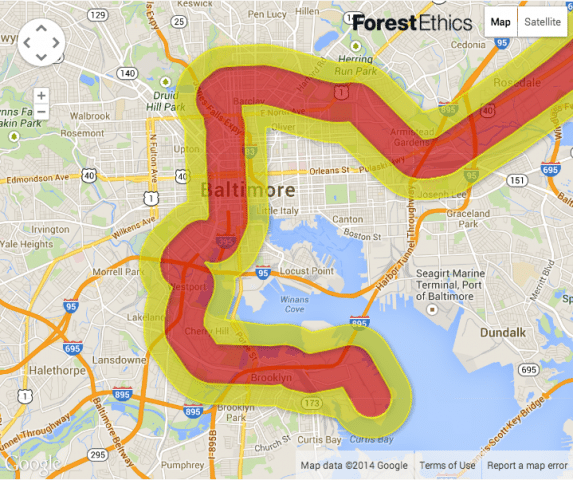As part of the ongoing oil-by-rail Week of Action, ForestEthics has launched a new Oil Train Blast Zone website that allows people to search their address and determine if they are within the estimated blast zones for the trains carrying highly flammable crude oil, known as “bomb trains.”
“Millions of North Americans live in the blast zone, do you?” asks Todd Paglia, ForestEthics executive director. “Citizens understand the danger, it’s time for policy makers to catch up and step up.”
The website shows the current known routes of the oil trains and highlights the areas that fall within the Department of Transportation’s recommended evacuation zones for oil train derailments (0.5 miles) and the potential impact zones if there is an oil train fire (1.0 mile).
Finding yourself within these blast zone areas is particularly troubling because, as previously reported on DeSmogBlog, it has been well established that no community is prepared to respond to a worst case scenario oil train accident.
Due to the explosive nature of the oil and the continued use of unsafe DOT-111 tanker cars, even in accidents only involving a few cars rupturing and burning, like the one in Lynchburg, Virginia, first responders have taken the approach of just letting the tank cars and oil burn itself out instead of trying to put the fire out.
As part of the Week of Action, protests were held across the country recently to mark the July 6th anniversary of the oil train disaster in Lac-Megantic and to demand an end to the oil trains.
In Albany, NY, which has become one of the top destinations for oil trains filled with Bakken crude oil, an event was held at the Ezra Prentice apartments which are located directly along tracks that regularly have the oil tank cars parked on them or moving along them.
While the event was a vigil for the 47 people who died in Lac-Megantic a year ago, there was plenty of talk about the fact that these apartments and many others in Albany were located within the blast zone.
Pastor McKinley Johnson, whose church is located near the tracks and within the blast zone, spoke to the gathering about how the Bakken oil trains had been allowed to come to Albany without anyone in the community knowing about it.
“For this to occur without any real exposure to let you know what crude oil was all about and how if it is triggered what it would do,” McKinley said, “Say what you want to, if any one of those tanks blow up, this area is gone.”
This fact has not been lost on the residents of the Ezra Prentice apartments, some of whom are now asking to be relocated out of any potential blast zone.
This past week in Lac-Megantic, it was still very clear where the blast zone was from that accident a year ago. While the train company has been purchased by the massive New York hedge fund Fortress Investment Group and the tracks have been rebuilt, downtown is still fenced off so that the work of continuing to remove the contaminated soil can continue.
The trains have returned but Lac-Megantic is a long way from being rebuilt.
In addition to the blast zone tool on the website, ForestEthics has included a petition asking President Obama and Congress to stop the unsafe oil trains.
“These oil trains are an unacceptable threat, especially because we don’t even need this extreme oil,” says Paglia. “Oil use in the US and Canada is down, climate risks are up, and when you put these things together the only sane thing to do is ban these exploding trains.”
Meanwhile, Big Oil is saying the trains are safe with claims that Bakken crude is no different than any other crude oil and lobbying against new regulations in private meetings at the White House.
This battle between the communities along the tracks and the oil and rail companies was summed up well by the chorus of a song played at the Albany vigil. “Bomb trains, bomb trains, how many lives will be sacrificed, for Big Oil’s corporate gains?”
Subscribe to our newsletter
Stay up to date with DeSmog news and alerts






